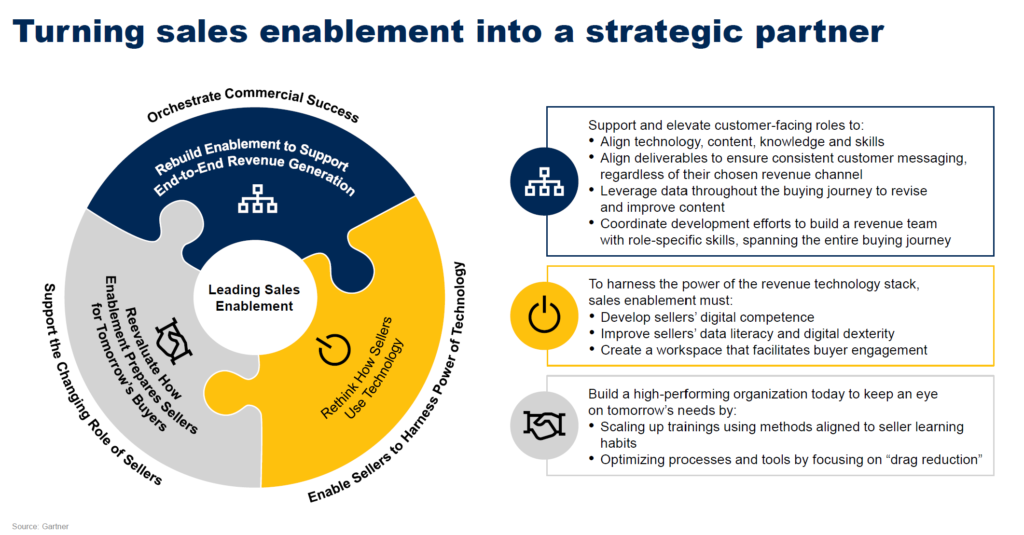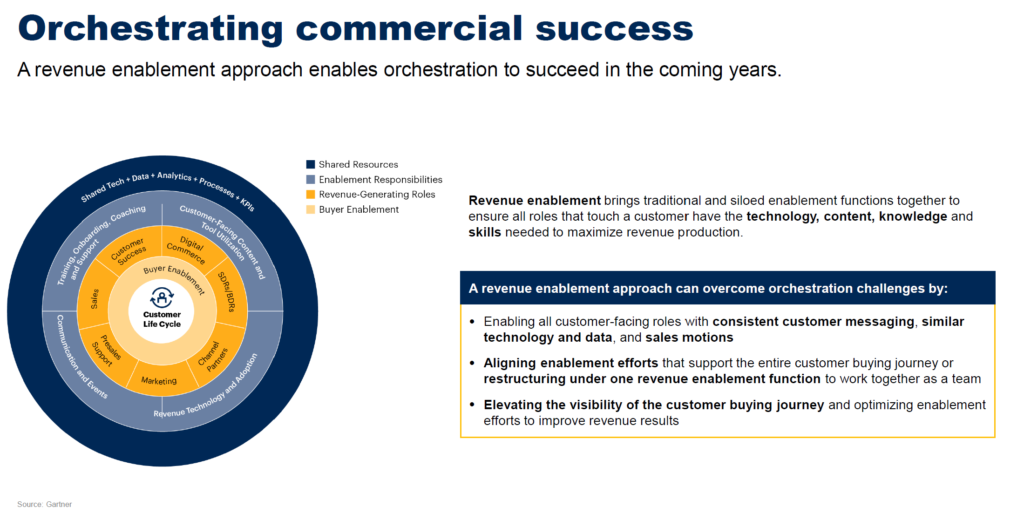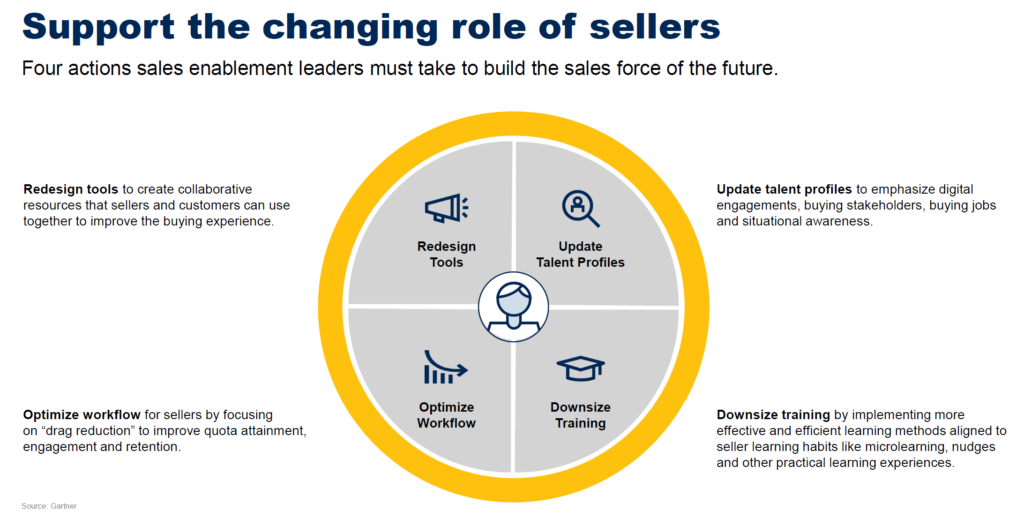
Review of Sales Enablement Leadership Vision 2023
Introduction
Supported by research insights from Gartner, APACSMA has observed the shifting preferences of B2B buyers towards seller-free experiences and the increasing reliance on digital channels. This shift not only affects marketing, sales, and customer service but also has a significant impact on sales enablement. Sales leaders see that fragmented processes hinder customer experience, while sales enablement faces challenges adapting to economic turbulence.
This alignment with Gartner’s findings strengthens our understanding of the evolving landscape and reinforces the importance of adapting sales enablement strategies to meet the demands of modern buyers. With this collaborative approach, we are better equipped to guide businesses toward success in the dynamic marketplace by addressing key questions for transformation.

How can we build an enablement function for today’s commercial environment?

APACSMA draws the conclusion that in order to drive sustainable sales growth and revenue generation, organizations must transform sales enablement into a strategic partner that orchestrates commercial success. This involves aligning technology, content, knowledge, and skills to support end-to-end revenue generation, ensuring consistent customer messaging across revenue channels, leveraging data throughout the buying journey, and building a revenue team with role-specific skills.
Additionally, sellers need to be prepared for the changing landscape by developing digital competence, improving data literacy, and utilizing technology effectively. By following these strategies, organizations can adapt to the evolving marketplace and position themselves for success in the future.

How can sales enablement prepare sellers to drive commercial success using technology?
This showcases a strategic approach to orchestrating commercial success through revenue enablement. It emphasizes the integration of shared resources, enablement responsibilities, and the unification of traditional functions to maximize revenue production. It highlights the importance of consistent customer messaging, technology utilization, and unified sales motions across all customer-facing roles. Overall, APACSMA suggests that a well-structured revenue enablement strategy can overcome orchestration challenges, optimize the customer buying journey, and ultimately improve revenue results for businesses.
Additionally, sellers need to be prepared for the changing landscape by developing digital competence, improving data literacy, and utilizing technology effectively. By following these strategies, organizations can adapt to the evolving marketplace and position themselves for success in the future. Learn more about APACSMA’s Sales Operations Programme.

It can be concluded that there is a significant divide in opinions among professionals in the sales landscape regarding the impact of technology. While Chief Sales Officers (CSOs) overwhelmingly believe in the effectiveness of technology for meeting revenue targets, a notable portion of B2B sellers view technology as a hindrance to their overall efficiency. It also highlights a concerning lack of readiness among workers to adopt new, technology-driven ways of working, which could potentially impede the successful implementation of technological tools in sales environments. This readiness gap is a key factor that organizations need to address to ensure the effective utilization of technology in driving sales performance.
Overall, at APACSMA we think that while technology is seen as essential for sales success by some, there are challenges and differing perspectives that need to be navigated to fully leverage its potential in enhancing sales outcomes. Organizations may need to focus on addressing these challenges, improving readiness among employees, and finding ways to bridge the gap between differing views on the role of technology in sales. Learn more about APACSMA’s Sales Operations Programme.

It emphasizes the importance of enabling sellers to harness the power of revenue technology in today’s commercial environment. It highlights key areas such as Revenue Technology, Buyer Engagement, Simplified Workflows, and Essential Technologies, underscoring the need for sales enablement leaders to support sellers in effectively utilizing technology and data. To achieve this, sales enablement leaders should focus on helping sellers overcome technology adoption barriers, building sellers’ digital dexterity, developing their data literacy skills, and creating buyer engagement-focused workspaces.
By taking proactive steps in these areas, sales enablement leaders can empower sellers to leverage technology effectively, generate valuable insights, and streamline workflows to drive sales success. Overall, it serves as a comprehensive guide for sales enablement leaders to enhance the sales process through technological empowerment, ultimately leading to improved customer engagement and collaboration in a competitive commercial landscape.
How can sales enablement leaders help build a high performing sales team?

APACSMA can draw the conclusion that the role of sellers has evolved significantly, with a growing emphasis on virtual selling skills. It suggests that a large percentage of sellers have faced challenges in virtual deals that they believe they could have won in person, highlighting the importance of adapting to the virtual sales environment. The graph showing 90% of the sales force operating predominantly in a virtual capacity further underscores this shift. Additionally, the expectations of sellers regarding the future relevance of their skills indicate a recognition of the need for continuous adaptation and upskilling to remain competitive in the market. Overall, it conveys a message of the changing landscape of sales roles and the necessity for sellers to stay abreast of evolving trends and technologies to succeed in the modern business environment.

It can be concluded that sales enablement leaders need to adapt to the changing landscape of sales by implementing strategic actions to enhance the sales force for future success. The focus is on fostering collaboration, prioritizing digital engagements, optimizing workflows, and implementing more effective learning methods. By redesigning tools, updating talent profiles, and downsizing traditional training, companies can improve the buying experience, increase efficiency, and better align with modern seller learning habits. Overall, it emphasizes the importance of staying agile and proactive in response to evolving market dynamics to ensure sales teams are well-equipped to meet future challenges. Learn more about APACSMA’s Sales Operations Programme.

It is evident that a strategic and proactive approach to sales enablement is crucial in today’s rapidly evolving commercial landscape. This research highlights the importance of adapting to changing trends, leveraging technology, and developing digital skills to drive revenue and maintain seller engagement. It emphasizes the need for collaboration, data-driven insights, and continuous skill development to meet the diverse needs of buyers and sellers. Overall, it provides a comprehensive roadmap for sales enablement leadership, offering valuable insights and actionable steps to navigate the challenges and opportunities in the modern sales environment.
Awards and Recognitions

Follow Us on LinkedIn
All Rights Reserved.

















